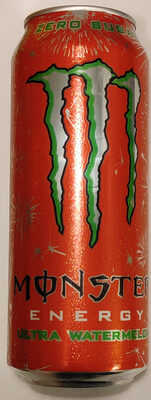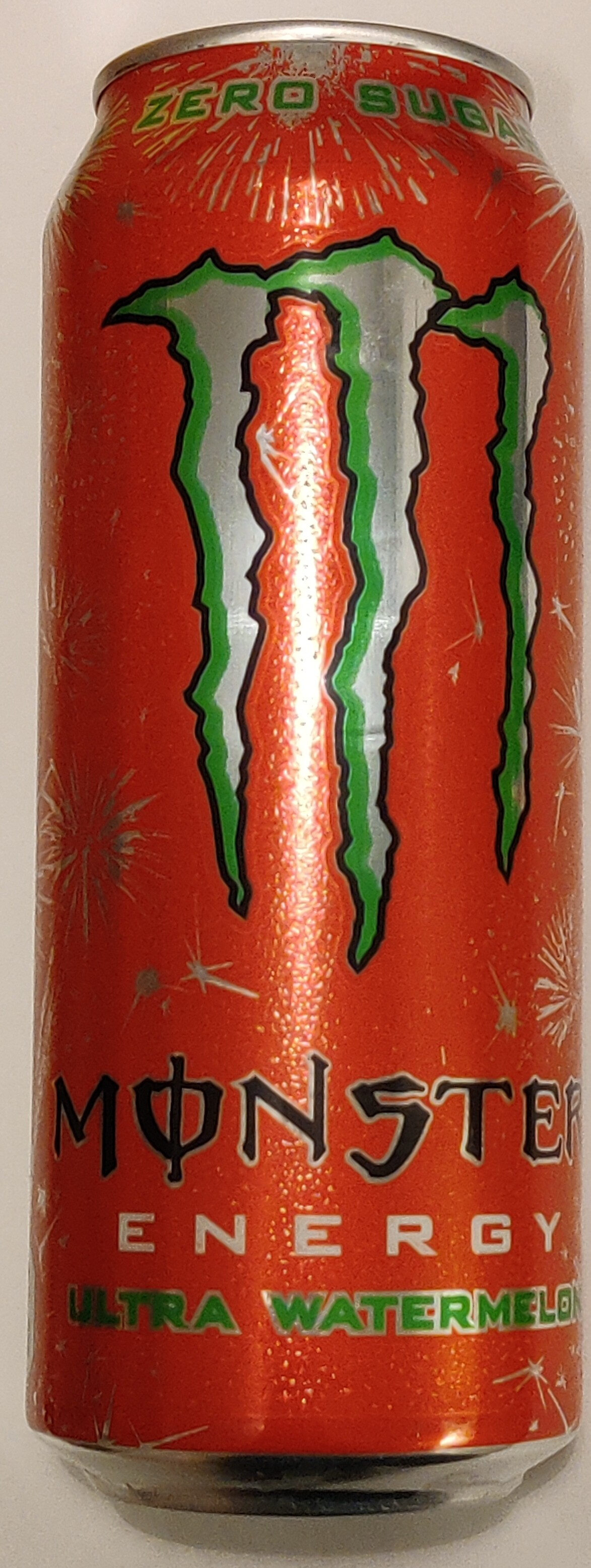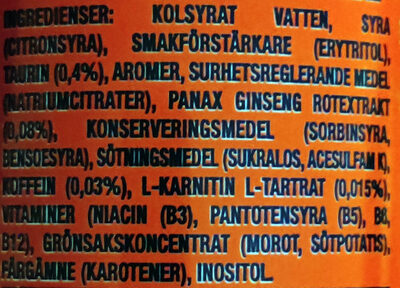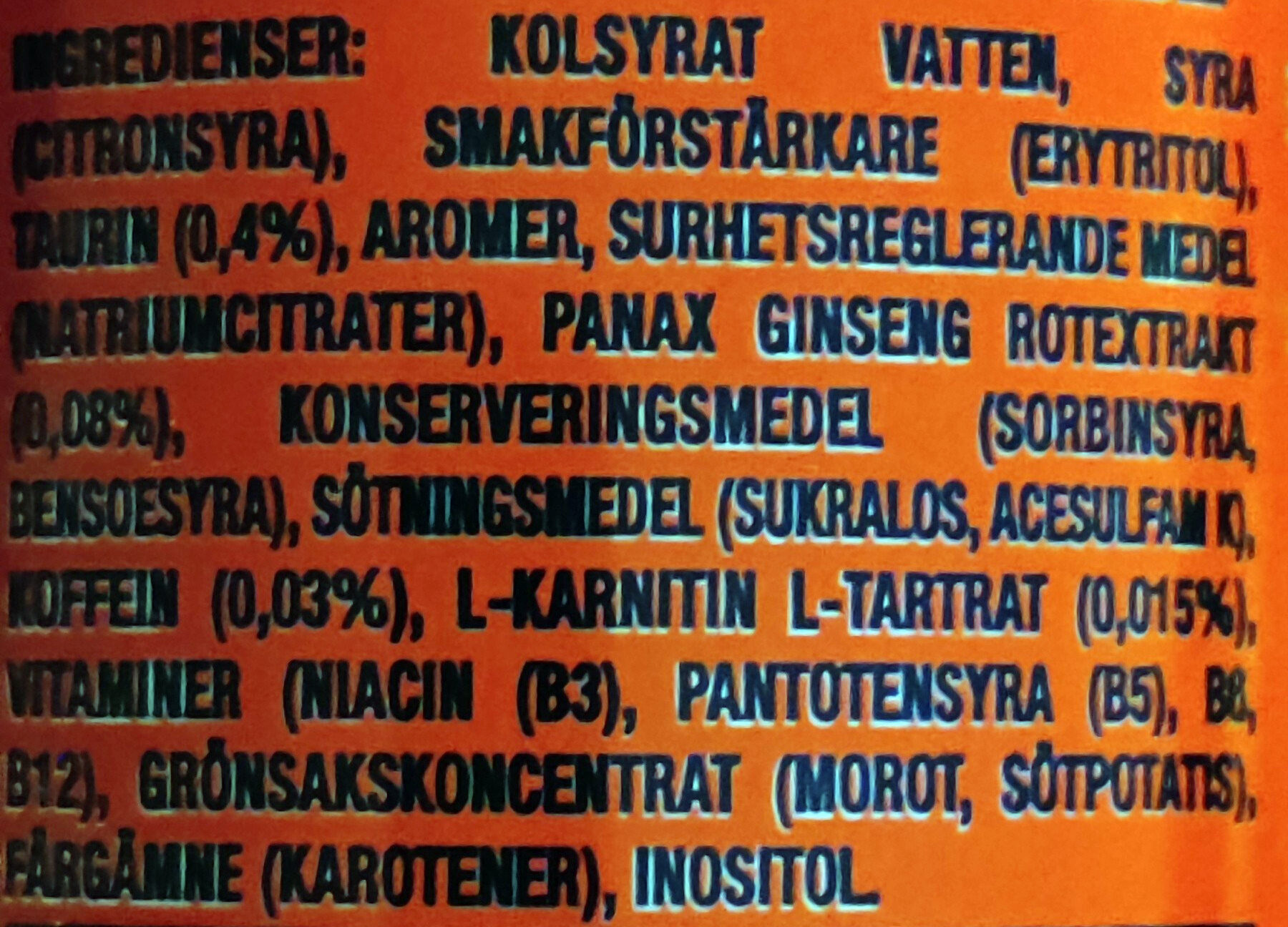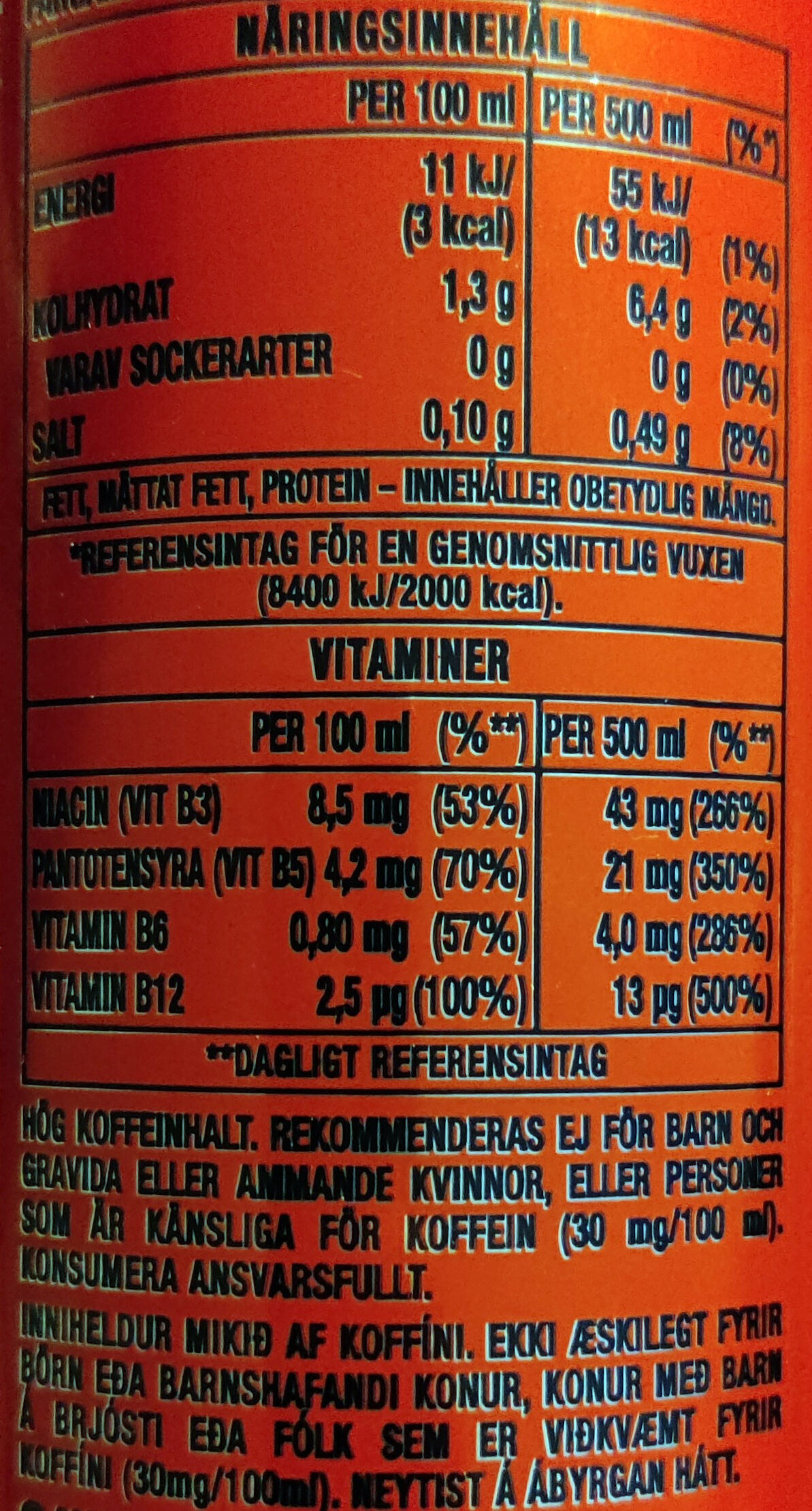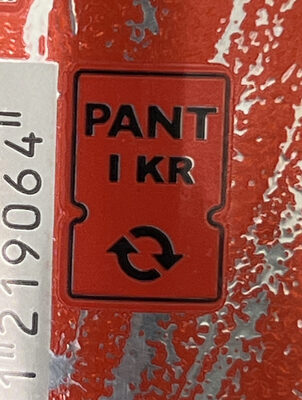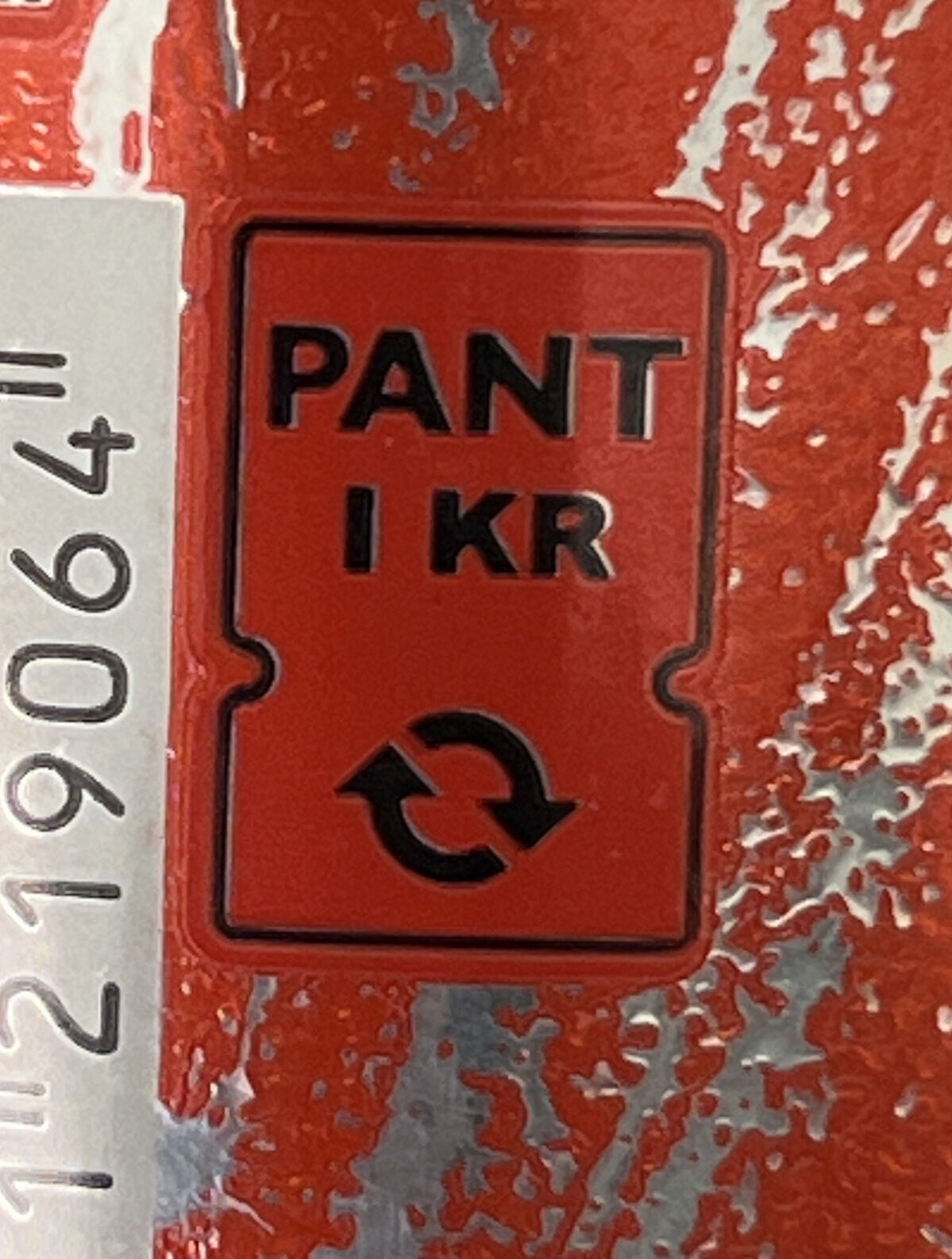Help us make food transparency the norm!
As a non-profit organization, we depend on your donations to continue informing consumers around the world about what they eat.
The food revolution starts with you!
Monster Energy - Ultra Watermelon - 500 ml
Monster Energy - Ultra Watermelon - 500 ml
This product page is not complete. You can help to complete it by editing it and adding more data from the photos we have, or by taking more photos using the app for Android or iPhone/iPad. Thank you!
×
Streckkod: 5060751219064 (EAN / EAN-13)
Kvantitet: 500 ml
Varumärken: Monster Energy, Monster
Kategorier: Drycker, Kolsyrade Drycker, en:Artificially sweetened beverages, Energidrycker, en:Energy drink without sugar and with artificial sweeteners
Butiker: City Gross
Länder där såld: Sverige
Matching with your preferences
Hälsa
Ingredienser
-
31 ingredienser
KOLSYRAT VATTEN, SYRA (CITRONSYRA), SMAKFÖRSTÄRKARE (ERYTRITOL), TAURIN (0,4%), AROMER, SURHETSREGLERANDE MEDEL NATRIUMCITRATER), PANAX GINSENG ROTEXTRAKT (0,08%), KONSERVERINGSMEDEL (SORBINSYRA, BENSOESYRA), SÖTNINGSMEDEL (SUKRALOS, ACESULFAM K, KOFFEIN (0,03%), L-KARNITIN L-TARTRAT (0,015%), VITAMINER (NIACIN (B3), PANTOTENSYRA (B5), B6, B12), GRÖNSAKSKONCENTRAT (MOROT, SÖTPOTATIS), FÄRGÄMNE (KAROTENER), INOSITOL.
Food processing
-
Ultra processed foods
Elements that indicate the product is in the 4 - Ultra bearbetade livsmedel och drycker group:
- Tillsats: E160a - Karoten
- Tillsats: E950 - Acesulfam k
- Tillsats: E955 - Sukralos
- Tillsats: E968 - Erytritol
- Ingrediens: Färg
- Ingrediens: Smakförstärkare
- Ingrediens: Arom
- Ingrediens: Sötningsmedel
Food products are classified into 4 groups according to their degree of processing:
- Obearbetade eller minimalt bearbetade livsmedel
- Bearbetade kulinariska ingredienser
- Halvfabrikat
- Ultra processed foods
The determination of the group is based on the category of the product and on the ingredients it contains.
Tillsatser
-
E160a - Karoten
Carotene: The term carotene -also carotin, from the Latin carota, "carrot"- is used for many related unsaturated hydrocarbon substances having the formula C40Hx, which are synthesized by plants but in general cannot be made by animals -with the exception of some aphids and spider mites which acquired the synthesizing genes from fungi-. Carotenes are photosynthetic pigments important for photosynthesis. Carotenes contain no oxygen atoms. They absorb ultraviolet, violet, and blue light and scatter orange or red light, and -in low concentrations- yellow light. Carotenes are responsible for the orange colour of the carrot, for which this class of chemicals is named, and for the colours of many other fruits, vegetables and fungi -for example, sweet potatoes, chanterelle and orange cantaloupe melon-. Carotenes are also responsible for the orange -but not all of the yellow- colours in dry foliage. They also -in lower concentrations- impart the yellow coloration to milk-fat and butter. Omnivorous animal species which are relatively poor converters of coloured dietary carotenoids to colourless retinoids have yellowed-coloured body fat, as a result of the carotenoid retention from the vegetable portion of their diet. The typical yellow-coloured fat of humans and chickens is a result of fat storage of carotenes from their diets. Carotenes contribute to photosynthesis by transmitting the light energy they absorb to chlorophyll. They also protect plant tissues by helping to absorb the energy from singlet oxygen, an excited form of the oxygen molecule O2 which is formed during photosynthesis. β-Carotene is composed of two retinyl groups, and is broken down in the mucosa of the human small intestine by β-carotene 15‚15'-monooxygenase to retinal, a form of vitamin A. β-Carotene can be stored in the liver and body fat and converted to retinal as needed, thus making it a form of vitamin A for humans and some other mammals. The carotenes α-carotene and γ-carotene, due to their single retinyl group -β-ionone ring-, also have some vitamin A activity -though less than β-carotene-, as does the xanthophyll carotenoid β-cryptoxanthin. All other carotenoids, including lycopene, have no beta-ring and thus no vitamin A activity -although they may have antioxidant activity and thus biological activity in other ways-. Animal species differ greatly in their ability to convert retinyl -beta-ionone- containing carotenoids to retinals. Carnivores in general are poor converters of dietary ionone-containing carotenoids. Pure carnivores such as ferrets lack β-carotene 15‚15'-monooxygenase and cannot convert any carotenoids to retinals at all -resulting in carotenes not being a form of vitamin A for this species-; while cats can convert a trace of β-carotene to retinol, although the amount is totally insufficient for meeting their daily retinol needs.Källa: Wikipedia (Engelska)
-
E200 - Sorbinsyra
Sorbic acid: Sorbic acid, or 2‚4-hexadienoic acid, is a natural organic compound used as a food preservative. It has the chemical formula CH3-CH-4CO2H. It is a colourless solid that is slightly soluble in water and sublimes readily. It was first isolated from the unripe berries of the Sorbus aucuparia -rowan tree-, hence its name.Källa: Wikipedia (Engelska)
-
E210 - Bensoesyra
Benzoic acid: Benzoic acid , C7H6O2 -or C6H5COOH-, is a colorless crystalline solid and a simple aromatic carboxylic acid. The name is derived from gum benzoin, which was for a long time its only known source. Benzoic acid occurs naturally in many plants and serves as an intermediate in the biosynthesis of many secondary metabolites. Salts of benzoic acid are used as food preservatives and benzoic acid is an important precursor for the industrial synthesis of many other organic substances. The salts and esters of benzoic acid are known as benzoates .Källa: Wikipedia (Engelska)
-
E330 - Citronsyra
Citric acid: Citric acid is a weak organic acid that has the chemical formula C6H8O7. It occurs naturally in citrus fruits. In biochemistry, it is an intermediate in the citric acid cycle, which occurs in the metabolism of all aerobic organisms. More than a million tons of citric acid are manufactured every year. It is used widely as an acidifier, as a flavoring and chelating agent.A citrate is a derivative of citric acid; that is, the salts, esters, and the polyatomic anion found in solution. An example of the former, a salt is trisodium citrate; an ester is triethyl citrate. When part of a salt, the formula of the citrate ion is written as C6H5O3−7 or C3H5O-COO-3−3.Källa: Wikipedia (Engelska)
-
E331 - Natriumcitrater
Sodium citrate: Sodium citrate may refer to any of the sodium salts of citrate -though most commonly the third-: Monosodium citrate Disodium citrate Trisodium citrateThe three forms of the salt are collectively known by the E number E331. Sodium citrates are used as acidity regulators in food and drinks, and also as emulsifiers for oils. They enable cheeses to melt without becoming greasy.Källa: Wikipedia (Engelska)
-
E950 - Acesulfam k
Acesulfame potassium: Acesulfame potassium - AY-see-SUL-faym-, also known as acesulfame K -K is the symbol for potassium- or Ace K, is a calorie-free sugar substitute -artificial sweetener- often marketed under the trade names Sunett and Sweet One. In the European Union, it is known under the E number -additive code- E950. It was discovered accidentally in 1967 by German chemist Karl Clauss at Hoechst AG -now Nutrinova-. In chemical structure, acesulfame potassium is the potassium salt of 6-methyl-1‚2,3-oxathiazine-4-3H--one 2‚2-dioxide. It is a white crystalline powder with molecular formula C4H4KNO4S and a molecular weight of 201.24 g/mol.Källa: Wikipedia (Engelska)
-
E955 - Sukralos
Sucralose: Sucralose is an artificial sweetener and sugar substitute. The majority of ingested sucralose is not broken down by the body, so it is noncaloric. In the European Union, it is also known under the E number E955. It is produced by chlorination of sucrose. Sucralose is about 320 to 1‚000 times sweeter than sucrose, three times as sweet as both aspartame and acesulfame potassium, and twice as sweet as sodium saccharin. Evidence of benefit is lacking for long-term weight loss with some data supporting weight gain and heart disease risks.It is stable under heat and over a broad range of pH conditions. Therefore, it can be used in baking or in products that require a long shelf life. The commercial success of sucralose-based products stems from its favorable comparison to other low-calorie sweeteners in terms of taste, stability, and safety. Common brand names of sucralose-based sweeteners are Splenda, Zerocal, Sukrana, SucraPlus, Candys, Cukren, and Nevella. Canderel Yellow also contains sucralose, but the original Canderel and Green Canderel do not.Källa: Wikipedia (Engelska)
-
E968 - Erytritol
Erythritol: Erythritol --2R,3S--butane-1‚2,3‚4-tetrol- is a sugar alcohol -or polyol- that has been approved for use as a food additive in the United States and throughout much of the world. It was discovered in 1848 by Scottish chemist John Stenhouse. It occurs naturally in some fruit and fermented foods. At the industrial level, it is produced from glucose by fermentation with a yeast, Moniliella pollinis. Erythritol is 60–70% as sweet as sucrose -table sugar- yet it is almost noncaloric, does not affect blood sugar, does not cause tooth decay, and is partially absorbed by the body, excreted in urine and feces. Under U.S. Food and Drug Administration -FDA- labeling requirements, it has a caloric value of 0.2 kilocalories per gram -95% less than sugar and other carbohydrates-, though nutritional labeling varies from country to country. Some countries, such as Japan and the United States, label it as zero-calorie; the European Union labels it 0 kcal/g.Källa: Wikipedia (Engelska)
Ingrediensanalys
-
Kan innehålla palmolja
Ingredienser som kan innehålla palmolja: E160a
-
Icke-vegan
Non-vegan ingredients: L-karnitin-L-tartrat
-
Vegetarisk status okänd
Okända ingredienser: Kobalamin
-
Details of the analysis of the ingredients
sv: KOLSYRAT VATTEN, SYRA (CITRONSYRA), SMAKFÖRSTÄRKARE (ERYTRITOL), TAURIN 0.4%, AROMER, SURHETSREGLERANDE MEDEL (NATRIUMCITRATER), PANAX GINSENG ROTEXTRAKT 0.08%, KONSERVERINGSMEDEL (SORBINSYRA, BENSOESYRA), SÖTNINGSMEDEL, SUKRALOS, ACESULFAM K, KOFFEIN 0.03%, L-KARNITIN L-TARTRAT 0.015%, vitaminer, NIACIN, vitamin B3, PANTOTENSYRA, vitamin B5, vitamin B6, vitamin B12, GRÖNSAKSKONCENTRAT (MOROT, SÖTPOTATIS), FÄRGÄMNE (KAROTENER), INOSITOL- KOLSYRAT VATTEN -> en:carbonated-water - vegan: yes - vegetarian: yes - ciqual_food_code: 18066 - percent_min: 15.7425 - percent_max: 98.395
- SYRA -> en:acid - percent_min: 0.4 - percent_max: 49.3975
- CITRONSYRA -> en:e330 - vegan: yes - vegetarian: yes - percent_min: 0.4 - percent_max: 49.3975
- SMAKFÖRSTÄRKARE -> en:flavour-enhancer - percent_min: 0.4 - percent_max: 33.065
- ERYTRITOL -> en:e968 - vegan: yes - vegetarian: yes - percent_min: 0.4 - percent_max: 33.065
- TAURIN -> en:taurine - vegan: maybe - vegetarian: maybe - percent_min: 0.4 - percent: 0.4 - percent_max: 0.4
- AROMER -> en:flavouring - vegan: maybe - vegetarian: maybe - percent_min: 0.08 - percent_max: 0.4
- SURHETSREGLERANDE MEDEL -> en:acidity-regulator - percent_min: 0.08 - percent_max: 0.4
- NATRIUMCITRATER -> en:e331 - vegan: yes - vegetarian: yes - percent_min: 0 - percent_max: 0.4
- PANAX GINSENG ROTEXTRAKT -> en:panax-ginseng-root-extract - vegan: yes - vegetarian: yes - percent_min: 0.08 - percent: 0.08 - percent_max: 0.08
- KONSERVERINGSMEDEL -> en:preservative - percent_min: 0.03 - percent_max: 0.08
- SORBINSYRA -> en:e200 - vegan: yes - vegetarian: yes - percent_min: 0 - percent_max: 0.08
- BENSOESYRA -> en:e210 - vegan: yes - vegetarian: yes - percent_min: 0 - percent_max: 0.08
- SÖTNINGSMEDEL -> en:sweetener - percent_min: 0.03 - percent_max: 0.08
- SUKRALOS -> en:e955 - vegan: yes - vegetarian: yes - percent_min: 0.03 - percent_max: 0.08
- ACESULFAM K -> en:e950 - vegan: yes - vegetarian: yes - percent_min: 0.03 - percent_max: 0.08
- KOFFEIN -> en:caffeine - vegan: yes - vegetarian: yes - percent_min: 0.03 - percent: 0.03 - percent_max: 0.03
- L-KARNITIN L-TARTRAT -> en:l-carnitine-l-tartrate - vegan: no - vegetarian: maybe - percent_min: 0.015 - percent: 0.015 - percent_max: 0.015
- vitaminer -> en:vitamins - vegan: yes - vegetarian: yes - percent_min: 0 - percent_max: 0.015
- NIACIN -> en:e375 - vegan: maybe - vegetarian: maybe - percent_min: 0 - percent_max: 0.015
- vitamin B3 -> en:e375 - vegan: maybe - vegetarian: maybe - percent_min: 0 - percent_max: 0.015
- PANTOTENSYRA -> en:pantothenic-acid - vegan: yes - vegetarian: yes - percent_min: 0 - percent_max: 0.015
- vitamin B5 -> en:pantothenic-acid - vegan: yes - vegetarian: yes - percent_min: 0 - percent_max: 0.015
- vitamin B6 -> en:vitamin-b6 - vegan: yes - vegetarian: yes - percent_min: 0 - percent_max: 0.015
- vitamin B12 -> en:vitamin-b12 - percent_min: 0 - percent_max: 0.015
- GRÖNSAKSKONCENTRAT -> en:vegetable-concentrate - vegan: yes - vegetarian: yes - percent_min: 0 - percent_max: 0.015
- MOROT -> en:carrot - vegan: yes - vegetarian: yes - ciqual_food_code: 20009 - percent_min: 0 - percent_max: 0.015
- SÖTPOTATIS -> en:sweet-potato - vegan: yes - vegetarian: yes - ciqual_food_code: 4101 - percent_min: 0 - percent_max: 0.015
- FÄRGÄMNE -> en:colour - percent_min: 0 - percent_max: 0.015
- KAROTENER -> en:e160a - vegan: maybe - vegetarian: maybe - from_palm_oil: maybe - percent_min: 0 - percent_max: 0.015
- INOSITOL -> en:inositol - vegan: yes - vegetarian: yes - percent_min: 0 - percent_max: 0.015
Näring
-
Good nutritional quality
⚠ ️Varning: mängden fibrer är inte angiven, eventuella positiv inverkan på betyget kunde inte beaktas.⚠ ️Warning: the amount of fruits, vegetables and nuts is not specified on the label, it was estimated from the list of ingredients: 0This product is considered a beverage for the calculation of the Nutri-Score.
Positiva poäng: 0
- Proteiner: 0 / 5 (värde: 0.1, avrundat värde: 0.1)
- Fiber: 0 / 5 (värde: 0, avrundat värde: 0)
- Frukt, grönsaker, nötter och raps- / valnöt- / olivoljor: 0 / 10 (värde: 0.0075, avrundat värde: 0)
Negativa poäng: 1
- Energi: 1 / 10 (värde: 11, avrundat värde: 11)
- Socker: 0 / 10 (värde: 0, avrundat värde: 0)
- Mättat fett: 0 / 10 (värde: 0.1, avrundat värde: 0.1)
- Natrium: 0 / 10 (värde: 40, avrundat värde: 40)
The points for proteins are counted because the negative points are less than 11.
Näringsvärde: (1 - 0)
Nutri-Score:
-
Näringsvärden
-
Fett i låg kvantitet (0.1%)
What you need to know- A high consumption of fat, especially saturated fats, can raise cholesterol, which increases the risk of heart diseases.
Recommendation: Limit the consumption of fat and saturated fat- Choose products with lower fat and saturated fat content.
-
Mättat fett i låg kvantitet (0.1%)
What you need to know- A high consumption of fat, especially saturated fats, can raise cholesterol, which increases the risk of heart diseases.
Recommendation: Limit the consumption of fat and saturated fat- Choose products with lower fat and saturated fat content.
-
Sockerarter i låg kvantitet (0%)
What you need to know- A high consumption of sugar can cause weight gain and tooth decay. It also augments the risk of type 2 diabetes and cardio-vascular diseases.
Recommendation: Limit the consumption of sugar and sugary drinks- Sugary drinks (such as sodas, fruit beverages, and fruit juices and nectars) should be limited as much as possible (no more than 1 glass a day).
- Choose products with lower sugar content and reduce the consumption of products with added sugars.
-
Salt i låg kvantitet (0.1%)
What you need to know- A high consumption of salt (or sodium) can cause raised blood pressure, which can increase the risk of heart disease and stroke.
- Many people who have high blood pressure do not know it, as there are often no symptoms.
- Most people consume too much salt (on average 9 to 12 grams per day), around twice the recommended maximum level of intake.
Recommendation: Limit the consumption of salt and salted food- Reduce the quantity of salt used when cooking, and don't salt again at the table.
- Limit the consumption of salty snacks and choose products with lower salt content.
-
-
Näringsfakta
Näringsfakta Som såld
för 100 g / 100 mlSom såld
per portion (500 ml)Compared to: en:Energy drink without sugar and with artificial sweeteners Energi 11 kj
(3 kcal)55 kj
(15 kcal)- Fett 0,1 g 0,5 g +541 % Mättat fett 0,1 g 0,5 g +966 % Kolhydrat 1,3 g 6,5 g +124 % Sockerarter 0 g 0 g Fiber ? ? Protein 0,1 g 0,5 g +5 % Salt 0,1 g 0,5 g −8 % Vitamin B3 8,5 mg 42,5 mg +33 % Vitamin B6 0,8 mg 4 mg +48 % Vitamin B12 (cobalamin) 2,5 µg 12,5 µg +68 % Vitamin B5 (Pantotensyra) 4,2 mg 21 mg +16 % Koffein 32 mg 160 mg +3 % Fruits‚ vegetables‚ nuts and rapeseed‚ walnut and olive oils (estimate from ingredients list analysis) 0,008 % 0,008 %
Miljö
-
Eco-Score not yet applicable
Not yet applicable for the category: Energidrycker
The Eco-Score is not yet applicable for this category, but we are working on adding support for it.
Förpackning
-
Packaging with a medium impact
-
Packaging parts
Can (Metal)
-
Packaging materials
Material % Packaging weight Packaging weight per 100 g of product Metal
-
Transportation
-
Origins of ingredients
Missing origins of ingredients information
⚠ ️ The origins of the ingredients of this product are not indicated.
If they are indicated on the packaging, you can modify the product sheet and add them.
If you are the manufacturer of this product, you can send us the information with our free platform for producers.Add the origins of ingredients for this product Add the origins of ingredients for this product
Report a problem
-
Incomplete or incorrect information?
Category, labels, ingredients, allergens, nutritional information, photos etc.
If the information does not match the information on the packaging, please complete or correct it. Open Food Facts is a collaborative database, and every contribution is useful for all.
Datakällor
Produkt tillagd den av akitainu
Senast ändrad produktsida på av ompopo.
Produktsida också redigerad av ecoscore-impact-estimator, openfoodfacts-contributors, packbot.
